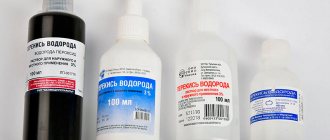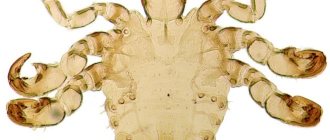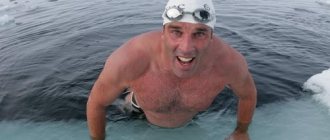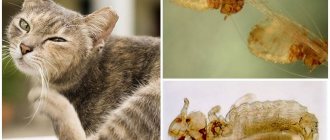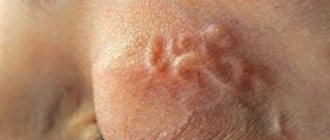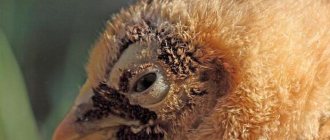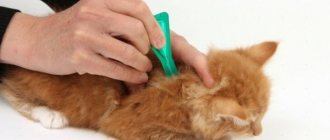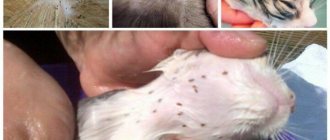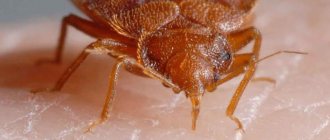Hair coloring
The opinion that you can get rid of lice and nits by dyeing is widespread among people. Does hair dye kill nits?
This is a truly effective remedy, however, there are nuances here: you will have to paint several times to completely destroy the insects.
It is also recommended to combine coloring with the use of medications or folk remedies.
Operating principle
So, how does paint affect parasites? The paint contains two components:
- coloring matter (pigment);
- oxidizer
The pigment does not have a significant effect on insects. Their destruction occurs due to an oxidizing agent, which is usually hydrogen peroxide.
Hydrogen peroxide is known for its ability to destroy molecules of organic substances, leading to their disintegration. When an oxidizing agent hits the chitinous cover of an insect, it immediately begins to corrode it, and toxic fumes enter the respiratory tract of the parasite.
So the insect dies immediately. And the lice that did not die after the action of the oxidizing agent try to leave the poisonous environment hostile to them and crawl away.
The oxidizing agent, which is aggressive in its chemical properties, also corrodes the dense protective covers of nits and the adhesive substance that attaches them to the hairs.
Coloring kills up to 85% of parasites.
Instructions for use
Today there is a huge variety of colors.
Permanent paints that do not contain hydrogen peroxide have become very popular.
Such paints should not be purchased in order to combat nits and seams.
In order not to worry whether hair dye will kill nits, you need to follow these instructions to combat parasites:
- Prepare for coloring. Put on an old T-shirt that you don't mind getting dirty, and take gloves. Mix the paint in a container (preferably a bowl), following the instructions on the package.
- Comb your hair thoroughly and spray it with water from a spray bottle (do not wet it completely - this will worsen the effect of hydrogen peroxide).
- Apply the thick cream along the hairline on the forehead, behind the ears, and at the back of the head so that paint does not accidentally get into these areas.
- Start painting. Divide your hair into strands and start coloring from the lowest ones, closest to the back of your head. Paint thoroughly from roots to ends. Move gradually towards the temples. Whiskey should be colored last, because... They are thin and quickly absorb pigment.
- Comb your hair again so that the dye is distributed evenly.
- Place a plastic bag or cap on your head. Leave the paint on your head for the time specified in the paint instructions. Typically this time is 20-30 minutes. During this time, the oxidizing agent will act on lice and nits.
- After the dyeing time has expired, remove the plastic bag and lightly spray your hair with a spray bottle, then massage your head. This will improve hair quality and increase blood flow to the hair follicles and scalp, which may be damaged by oxidizing agents. Also, using this action you will unstick dead nits.
- Rinse your hair thoroughly. An excellent option would be to use anti-pediculosis shampoo.
- Comb your hair with a comb or a special comb to get rid of dead lice and nits.
Advantages and disadvantages
Coloring as a remedy against pediculosis has undeniable advantages:
- Economical. The price for one pack of paint is less than the price for one pack of anti-lice medication.
- Effective in the fight against nits and lice.
- No harm. When used correctly, the paint causes minimal harm to health, because This is a proven remedy.
- Ease of use.
Like any drug, paint also has its disadvantages:
- Changing hair color. If you are not ready to change your hair color, then this method is not suitable for you.
- Allergic reaction. Before using paint, you need to do a test to see if it will cause an allergy.
- Weakening of the scalp. The pigment and oxidizing agent that make up the paint are chemically active substances and have an aggressive effect on the scalp and hair condition.
Despite the fact that paint is an effective remedy, its one-time use is not enough for the final removal of nits and lice.
It is necessary to re-dye it after a week or treat the hair with other means: medicines or folk remedies.
How to get rid of lice without unnecessary problems?
The main problem in the treatment of head lice is that lice quickly adapt to toxic substances (insecticides) and stop responding to them. "Paranit" has a fundamentally new mechanism of action. They contain dimethicone and mineral oil.
Dimethicone is a silicone-based polymer that is found in many cosmetics. It helps moisturize the skin, creating a thin barrier. So why did this substance, safe and beneficial for humans, become destructive for parasites?
The answer lies in the life activity of lice. They have seven openings (spiracles) on each side of the body that merge into the trachea. The tracheae branch and form a thin network that supplies insects with oxygen. Through the same network they remove excess fluid after drinking blood. Due to the high surface tension of water, it does not penetrate the microscopic spiracles. And dimethicone copes with this task. It tightly clogs the respiratory system of lice, depriving them of oxygen and disrupting their water balance. This substance also affects nits in the same way - without the ability to breathe, they die.
Since dimethicone and mineral oil are non-toxic substances, Paranit anti-pediculosis products can be used to treat children from 3 years of age, and Paranit Sensitive lotion is suitable for children from 1 year of age and pregnant women. In addition, the processing can be repeated many times. Paranit products are available in various forms, and therefore are suitable for treating all family members. This is a simple and effective way to deal with an unpleasant problem without risk to health.
Does hair dye kill lice and nits?
So, is it possible to remove lice by dyeing? Will the parasites disappear if a chemical is applied to the hair? Only a dye, the composition of which is enriched with aggressive components, for example, hydrogen peroxide, perhydrol, kills lice and nits. Modern dyeing products have a mild effect and do not have a negative effect on hair or lice.
Video
Treatment of pediculosis (lice) in adults: combing, comb, dye and hair straightener, steam, frost
5:02 minute (about paint)
Effect of hair dye on lice
It was previously believed that if you dyed your hair, the lice would die. In a sense, this is true, because previously the modern market offered users exclusively products containing aggressive chemicals.
However, the use of products containing oxidizing agents allows you to obtain a slightly different effect. Aggressive paint has a negative effect on lice and nits, destroying the chitinous integument, leading to the death of the parasite. As for lice eggs, the substances contained in hair products destroy the sticky mucus through which they are attached to the shaft. By thoroughly rinsing the hair, the eggs are washed out, after which they should be destroyed.
How does an oxidizing agent work on nits?
So, whether hair dye helps against lice is a rather controversial issue. You can kill parasites only with repeated use of an aggressive hair dye.
As for nits, paints, which contain various oxidizing agents, have a destructive effect on the sticky mucus produced by parasites, with which they are fixed to the hair. Without support, lice can be easily combed out or washed out of the hair.
What dyes are suitable for combating head lice?
There are several types of hair dye that kill lice and help remove nits. Regardless of other characteristics, such dyes include products containing ammonia and hydrogen peroxide. In addition, to destroy lice, you can use paint made from natural ingredients, namely henna or basma.
Since lice larvae stick to the hair, after dyeing you need to wash it thoroughly with shampoo or comb out the lice with a sparse comb. Several staining treatments may be required to completely eliminate lice. In the early stages of a flea infestation, one procedure may be sufficient.
Is it possible to remove lice by dyeing?
People often use hair dye as a panacea for lice and nits, and believe that there is no need to purchase expensive pharmaceutical products. There is an opinion that you can get rid of parasites by dyeing your hair. This method intrigues women. At the same time, change your image and recover from blood suckers.
Hair dye solves these issues. It has a characteristic odor and consists of components harmful to blood sucking. Of course, not every representative of the fair half of humanity will decide to radically change the color of her hair. In addition, everyone knows that dye significantly spoils the structure of the hair. However, this method mercilessly and quickly kills lice, and you can choose a color as close as possible to the natural shade.
Of course, not all parasites will die after dyeing the hair, but the bulk of them will still die. The remaining lice will be seriously weakened, the nits will peel off from the hair shaft and will easily come out during combing. If you use a special comb purchased at the pharmacy, weakened insects and eggs can be easily eliminated.
Important! When combing is not done, new lice develop from the nits; the weakened ones will soon recover and begin to multiply further. It is possible to completely get rid of pediculosis only with an integrated approach.
What to consider when painting
But if you really want to remove lice and nits using paint, you should use substances with perhydrol, ammonia and peroxide. This combination can negatively affect parasites, destroy their chitinous shell, paralyze their breathing and kill adult individuals. Nits do not die during dyeing, their shell is much thicker, so after the procedure it is necessary to comb the hair well with a comb, and after a few days repeat the combing procedure to remove newly hatched parasites.
Sequencing:
- dilute the paint according to the instructions;
- cover your shoulders and body with a cape, and put on impervious gloves on your hands;
- use a brush to apply dye to strands of hair;
- put a plastic cap on your head and a towel on top to create a “greenhouse”;
- keep the composition on your hair for the required amount of time;
- wash your hair with shampoo;
- carefully comb each strand with a lice comb and destroy them (do this in the bathroom, do not allow the parasites to scatter around the apartment);
- apply hair conditioner;
- After three days, repeat the procedure of combing out parasites.
Even if you have selected a suitable paint with ammonia, perhydrol and peroxide, treatment does not guarantee complete destruction of lice. 80% of the nits will remain on the head, and after combing out their number will drop to 1-10%, but even a few hatched nits can recreate a whole army of parasites.
We strongly recommend using special pharmaceutical preparations to destroy lice without harming your hair. With one dyeing you will not 100% kill all the bloodsuckers, and frequent repeated dyeing will damage your hair, make it burnt and split.
In order to completely get rid of lice, you need to not only destroy living individuals, but also remove all larvae (nits).
loading…
It turns out that the disease is much more widespread than statistics say. Why are people silent about head lice?
Although parasites often appear in the hair of quite prosperous and even successful people, society has not yet overcome the shame of this disease due to the outdated opinion that insufficient hygiene contributes to infection.
In fact, lice prefer cleanliness, since the absence of dirt and oil on the skin makes it easier for them to access food - blood.
How can you get lice? Sometimes pediculosis is discovered in people who have not come into close contact with an infected person.
https://www.youtube.com/watch?v=mGS4AuTy9Tc
As a result, lice began to be credited with almost supernatural abilities. Many are sure that parasites can jump or even fly.
In fact, lice roam using two of their abilities: moving quite quickly (at a speed of 20 cm/min) and tenacity due to special hooks on their paws.
An insect can fall on you in transport, and you can become infected in public places: in a bathhouse or swimming pool.
What other types of pediculosis are there? There are three types of lice: head, pubic and body lice. Accordingly, insects infect scalp hair, clothing or pubic hair.
Each species lives and reproduces exclusively in the place corresponding to its name. However, one person can be infected with several types of lice at the same time.
If you or your child become infected, animals have absolutely nothing to do with it.
How to get rid of lice? For the generation of grandmothers, insects in the hair were even more stressful than for modern people, because in their time there were no effective pediculicidal drugs.
They tried to remove lice with means like herbal decoctions or vegetable and berry juices. When this did not help, stronger means were used, such as kerosene.
Paint against lice and nits
Hair dye is one of the readily available ways to combat head lice. In addition, a short treatment procedure does not pose a particular health hazard, provided that the recommendations of the manufacturer of the coloring composition are followed.
To achieve a full result, three and sometimes even four procedures are necessary. Moreover, re-treatment should be carried out no more than after 6-7 days. It is unlikely that such an active effect on the hair and scalp will be beneficial. Also, do not forget about the risk of allergies to the coloring composition.
Pediculosis causes itching, burning and irritation of the skin, it is dangerous because it can cause the development of other diseases, and it is easy to become infected.
Under what conditions do head lice appear?
- when swimming in a polluted body of water;
- when using other people's personal belongings (combs, hairpins, clothes);
- in public transport;
- in close contact with an infected person.
Do lice live on colored hair?
Many women are convinced that regular dyeing helps get rid of lice. But practice shows that parasites feel equally good on clean or dirty, curly or straight, natural or dyed hair.
The chemicals contained in certain types of hair dyes do have a negative effect on lice, but this requires direct exposure. If the infection occurs after dyeing, then the parasites will live and multiply in the same way as on natural hair. Lice feed on blood. The chemicals contained in paints do not penetrate into the human bloodstream, otherwise we would experience unpleasant side effects after painting. Thus, changing hair color has no effect on lice.
Mechanical method - combing
This is a simple but very effective option for getting rid of parasites.
The method is completely harmless, therefore it is recommended for pregnant and lactating women, as well as children and anyone suffering from allergies. An anti-lice hair comb will do a good job of combing out parasites from washed, damp strands. Then, to avoid relapses, we repeat combing every 3 days for 2 weeks.
The sequence of such treatment
- Wash your hair with shampoo, pat the locks dry with a towel and apply conditioner.
- Now use a large comb to straighten the long curls, and then comb them repeatedly with a fine-toothed, wet comb.
- The moisture and conditioner will cause all the lice to become lethargic and get stuck in the teeth of the comb.
- Vinegar for hair against lice will help at this stage. We will moisten the comb with it, and then clean the hair from insect fragments with it.
- Wash your hair with shampoo again.
- Then dry your curls with a towel.
- Use a large comb to organize the long strands and, to control them, go through them with a fine-toothed comb.
This procedure is necessary for all infected people in the family.
We do the course at three-day intervals for half a month. This way we guarantee ourselves absolute freedom from parasites, because we will eliminate young larvae in a timely manner.
Remedy No. 1
AntiV prophylactic comb will get rid of lice on long curls.
- Long and frequent teeth made of medical steel will comb out even the smallest nits, because their interval is half that of the smallest nit.
- Withstands boiling and exposure to anti-pediculosis medications.
The comb is eternal, harmless, effective.
- Available in pharmacies and online. Price – about 1500 rubles.
- Rounded teeth with a laser notch do not scratch the head, but perfectly hold live insects and destroy the shell of the larva.
- AntiV does not break or pull out hairs, does not cause allergies or dandruff.
- Let's run it down the strands from the roots themselves and see if there is a problem. After all, newly deposited nits are located right at the roots.
Drawing conclusions
On the Internet you can find both bad and good reviews about the use of paints for head lice. Negative experiences, as a rule, are experienced by girls who choose modern, gentle paints without ammonia and hydrogen peroxide. Such remedies are powerless against larvae and adult parasites.
Also, negative consequences await women who apply makeup several times in a row with a short interval - their curls become dry and lifeless.
Remember that even medications do not provide a 100% guarantee; they must be reused after 14-15 days to consolidate the effect. This problem is much easier to prevent than to fix.
Be responsible about personal hygiene and do not share hats and combs with anyone to protect yourself from lice infection.
Ways to fight
Unfortunately, no one is immune from the appearance of pediculosis. You can catch it through contact with already infected people, in places where there is public bedding and underwear, in schools, kindergartens and even in hospitals. So what to do if there are lice on long hair? - Let's figure it out.
All existing methods of combating the disease can be divided into 2 groups:
- mechanical method - that is, direct removal of lice and nits from hair by combing or removal of the hair itself;
- chemical – exposure of parasites to substances harmful to them (and sometimes to us).
Using methods from both groups at the same time leads to success. If pediculosis appears in a child, then it makes sense to consult a specialist - a pediatrician or dermatologist before starting treatment.
You should also see a doctor if it recurs. Contacting a medical facility is only necessary to ensure that the medicine is selected correctly.
This will save you from wasting extra money and causing damage to your health.
Features of parasites
To know what methods to use to fight an enemy, you need to study his weaknesses.
Lice
Lice are small insects with a body length of up to 4 mm. They live on the head and feed on blood. They move with the help of tenacious legs. They are able to cover a distance of 35 cm in a minute. They cannot jump or fly. They react sharply to unpleasant odors. The body is protected by a dense shell, on the surface of which there are spiracles.
They feed every 2 hours, the process of food absorption lasts up to 40 minutes. If released into the environment - floor, bed, pillow, headdress - they die within 3 days. The lifespan of adults is 30-40 days. From 10 to 20 individuals can live on 1 head.
Louse and nit
Nits
Lice eggs. Oblong, oval in shape, with a cap at the base. The egg is about 1 mm long. The dense shell protects the larva from exposure to adverse factors. No chemicals can penetrate through it - kerosene, gasoline, vinegar, insecticides.
They are attached to the hair using a special adhesive substance that lice release when they lay eggs. Under the influence of oxygen, the mucus hardens and firmly fixes the nits to the hair. They are unable to move, cannot be washed off with soap, and cannot be combed out with a regular comb. The photo clearly shows what lice and nits look like in hair.
The larvae develop in the egg within 7-10 days. They gnaw through the cover of the shell and climb out. Empty nits remain on the hair. Small lice - nymphs lead the same lifestyle, but do not reproduce, since the formation of the genital organs takes another week. In 8 days, nymphs go through 3 molts, turn into sexually mature individuals, and then begin to reproduce.
How to dye
In order for hair coloring to help in the fight against head lice, first of all you should choose the necessary composition of the product. You need to carefully read the instructions for the content of hydrogen peroxide or ammonia in the paint. The most effective shades to achieve the desired goal will be blonde shades.
Next, you should check for hypersensitivity to components. If there is no redness or itching, then you can start coloring. The procedure should proceed as follows:
- It is prohibited to use expired medication;
- It is necessary to prepare the coloring mixture in strict compliance with the dosages specified in the instructions;
- before starting the procedure, you should wash your hair, dry it and remove dead insects using a comb;
- Next, you need to distribute the hair into strands and treat each of them with the prepared dye;
- put on a hat. If it is not there, then you can use a plastic bag;
- wrap yourself in a towel on top. This is necessary to create a greenhouse effect, which helps kill lice;
- leave the coloring agent for half an hour;
- then wash off the dye with detergent and warm water;
- Rinse your hair with lemon solution. To do this, dilute the juice of 1 lemon in 1.5 liters of warm water;
- dry your hair with a hairdryer;
- comb out nits and dead lice.
Causes of lice
To figure out whether a louse can appear on colored strands, you need to understand why it loves to live on the scalp.
Parasites only need your blood - this is the only component of their “diet”. The hairs are used by sexually mature females to attach nits - individuals secrete a special sticky secretion to attach their offspring to the cuticles. In such conditions, the new generation can develop normally. In fact, it makes no difference to lice or nits whether you have a natural hair color or acquired it using dyes, the main thing is that the blood circulation in the capillaries does not stop, and there are rods on which the larvae will grow.
The only thing that saves colored hair is changing its structure in the first two to three days after using the composition. Until the curls are restored, adult individuals have nowhere to attach the nits; they simply fall out. However, after a short time such an opportunity appears, and pediculosis develops at a rapid pace.
The conclusion is clear: lice can grow on both natural and dye-treated strands.
A lice lives for approximately 6 weeks, during which time it manages to produce several new colonies of parasites. Pediculosis can occur suddenly; very little time passes from the moment of infection to the appearance of nits; the disease develops rapidly.
How common is head lice?
In Russia, more than three hundred thousand cases of head lice are recorded every year. However, the number of products against lice and nits sold by pharmacies exceeds two million packages. It turns out that pediculosis is more widespread than is evident from the statistics.
This happens because people are ashamed of lice and do not always seek help from a doctor, trying to get rid of the disease on their own. And the difference in these indicators proves that not all products help remove lice and nits.
Children are more susceptible to infection because, unlike adults, they communicate freely with each other. But head lice can affect anyone.
Ancient peoples were much more afraid of lice than in the modern world with developed medicine. In those days, lice were treated exclusively with herbal infusions, vegetable and berry juices. When it was not possible to get rid of lice and nits, more atomic means such as kerosene entered the fight. However, this was an extreme measure, because the strong smell revealed a lousy person and his head was shaved. In the past, lice infestation was greatly feared, because they were carriers of dangerous and fatal diseases that developed into epidemics.
Lice prevention methods
Basic measures you can take to prevent the spread of lice to children and adults in your family:
- Do not share personal hygiene items (combs, towels).
- Avoid activities that result in head-to-head contact.
- Store items, especially outerwear, away from common areas such as closets.
If you have lice, try not to be embarrassed. This is not a sign of illness or that you or your child are dirty. Tell friends and teachers to check on their children and stop the spread of these pests.
- about the author
- VK profile
FAQ
Can there be lice on hair extensions?
You can use both real and synthetic hair extensions. Lice can attach to any type of hair, even hair extensions. Whether they survive or not depends on how long they are in your hair and whether you remove them. If you catch them in your hair extensions before they reach your scalp, you can avoid a lice infestation. However, if even one louse gets on your scalp, you need to take immediate action.
Are nits covered in hair coloring?
Parasites are not painted over because the components in the paint, such as ammonia or peroxide, are deadly to them. When paint gets on the shell of parasites, the insects' cover is corroded, which leads to their death.
What are nits
Nits are nothing more than lice eggs covered with a protective shell in the form of a cocoon. It is formed from the mucous secreted by the louse
secretion that quickly hardens in air. Thanks to this sticky substance, the nit is so firmly attached to the hair that it is difficult to remove even with a sharp object.
As a rule, nits are located on the hair 2 or 3 cm from its base. When observed with the naked eye, they appear as small white dots stuck to the hair and resemble a piece of dandruff. Upon closer examination, for example, through a microscope, it becomes clear that these are small elongated capsules.
Methods of disposal
The female lives 8 weeks and lays up to 300 nit eggs, which are not susceptible to poisons due to the protective cocoon. Relapses occur 5-10 days after the elimination of lice, so we always repeat treatment procedures.
| Chemical method - common | Mechanical - harmless | Combined - the most effective | |
| The essence of the method | Treatment of the entire hairline with anti-pediculosis drugs. | Removing lice and larvae with a special comb. | Alternate use of first a chemical method against lice, then a mechanical one (against nits). |
| pros | Many drugs will get rid of adult lice in just one use. | Allows you to remove larvae and sedentary insects from wet hair | By combining the chemical destruction of adult lice and the mechanical removal of their nits, we will immediately exterminate the entire population. We can even use mild toxic drugs that will preserve our hair. |
| Minuses | The larvae still survive in a strong cocoon, so several such procedures are necessary. Skin irritation, dandruff or allergies may occur. | We carry out several such procedures on long hair. | The most expensive method: we purchase both a comb and a chemical. |
Be vigilant or How to prevent infection?
Of course, there are no 100% methods that will protect a child from becoming infected with lice. However, it is possible to reduce this danger.
Prevention begins with the work of medical workers in schools and kindergartens. Because they must regularly check their pupils for nits and lice.
However, great responsibility still lies with you.
* Make it a rule to check your child for nits and lice once every 7-10 days.
* Periodically iron your child's hair with a hair straightener, as lice and nits die at high temperatures.
* Explain to your child several rules of behavior at school or kindergarten:
- You cannot share a hat, scarf, comb, or hair jewelry with other children.
— Before hanging outerwear in the common locker room, you need to turn it over to the wrong side and turn the outer one inside. This will reduce the likelihood of infection, because the louse does not know how to move on a smooth surface.
* If a girl has long hair, then put it in a ponytail or tie it in braids - the likelihood of infection will decrease.
In fact, if you have treated your child with an effective remedy, then he is no longer contagious - provided that you repeat the procedure after 7-10 days. Therefore, he can return to the children's team the very next day.
Temperature methods to combat pediculosis
If the temperatures at which adults and nits die are precisely known. You can fight them effectively by combining these methods with combing out insects with a special comb.
The following methods of combating ectoparasites are used:
Hair dryer - with its help you can destroy up to 96% of ectoparasites. To do this, set the hairdryer to maximum temperature (approximately + 50 C 0). They process each strand for at least three minutes. To treat hair near the skin, use a diffuser nozzle; it must be kept near the roots for a long time (about ten minutes). The head must first be washed with shampoo in the hottest water that a person can withstand. Then use a hairdryer strand by strand. The lice do not die, but become lethargic. They can be easily combed out using a special comb. They remain inactive for about an hour. Since this process does not kill the nits, the procedure will have to be repeated, given that new insects hatch from the eggs within seven to ten days.
Ironing - this method helps to effectively fight lice. You can also use a curling iron for this purpose. These devices kill all forms of parasites: adults, nymphs and nits. The iron burns the protective shell, as well as the substance with which the nits are attached to the hair. To get the most effective effect, you must first wash your hair with any shampoo. To avoid damaging your hair, it is recommended to apply heat protectants to it. It is necessary to divide the hair into thin strands and treat them one by one with heat curling irons. It is necessary to take at least three minutes to process one strand. Hair should be processed starting from the occipital and behind-the-ear areas. You need to smoothly and slowly pull the strand through the jaws of the iron from the roots to the ends of the hair. Then you need to comb out the parasites with a special comb. Treatment must be carried out twice a day.
Bath is considered a fairly effective method of fighting lice. It should be heated to a temperature of eighty degrees
Caution should be used with this type of treatment. Nits can tolerate high temperatures and live for a long time in the absence of the owner. Therefore, after treatment, it is necessary to carefully treat the room so as not to become infected again and to prevent lice from infecting other people.
When treating hair, you need to water your hair with the hottest water that a person can tolerate, and not just in a heated bath. Afterwards, the hair must be thoroughly treated with a hairdryer, then combed out with a comb. Three-time similar treatment is guaranteed to get rid of lice and nits.
Therefore, after treatment, it is necessary to carefully treat the room so as not to become infected again and to prevent lice from infecting other people. When treating hair, you need to water your hair with the hottest water that a person can tolerate, and not just in a heated bath. Afterwards, the hair must be thoroughly treated with a hairdryer, then combed out with a comb. A three-fold similar treatment is guaranteed to get rid of lice and nits.
Frost is an effective method for combating lice and nits found on things and body lice. Insects are guaranteed to die at a temperature of -20 C 0 during the day, so you can hang things out in the cold for this time. In summer, the patient’s belongings can be packed in a sealed bag and placed in the freezer for a day. To completely get rid of insects, you can repeat the procedure or iron things with an iron with hot steam, if this can be done. There is an opinion that to combat head lice, it is enough to walk down the street for several days without a hat. But this will not help; the temperature of the scalp is constantly maintained at a level sufficient for the comfortable existence of insects even in severe frost. This method is not at all suitable for controlling insects.
IMPORTANT! For more effective treatment, it is advisable to combine the temperature method of getting rid of lice with other methods (mechanical combing with a comb, treating hair with oils)
Alternative Treatments
All methods of getting rid of lice can be divided into three main groups:
- • Mechanical removal. This method involves removing live parasites and nits manually. To do this, take a fine-toothed comb and comb your hair thoroughly. The advantage of this method is that it is absolutely safe. Disadvantage: you will have to spend a lot of time and effort to completely get rid of lice.
- • Home remedies. There are a huge number of lice recipes that can be used at home. These include: essential oils, kerosene, mayonnaise, olive oil, vinegar and many others. The main disadvantage of these methods is low efficiency. In most cases, treatment is delayed and ultimately the insects have to be removed mechanically. The advantages include financial savings - most ingredients can be found in every kitchen
- • Pharmacy drugs. Today you can find a wide range of pediculicides in pharmacies. These can be shampoos, emulsions and sprays. The undoubted advantage of using pharmaceutical products is that they are all pre-tested and are considered relatively safe. The downside is that lice have become resistant to insecticides, so many drugs are simply ineffective.

